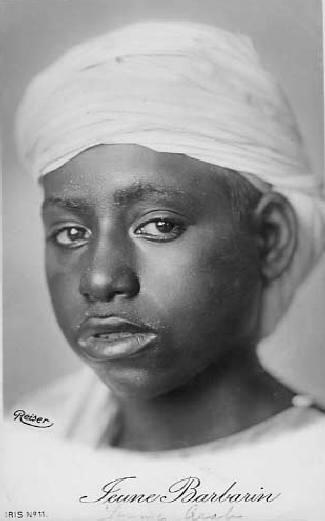
Egypt: Etnicity

Figure 1.--Egypt has one of the longest recorded histories of any country because it was one of the original river valley civilizations. The Nile Valley was, however, settled before the development of civilization an recorded history. One source of information on this ealy era is the etnicity of the Egyptin people. This portrait is one of a series of ethnic studies taken by a phoographer named Reiser.
|
|
Egypt has one of the longest recorded histories of any country because it was one of the original river valley civilizations. The Nile Valley was, however, settled before the development of civilization an recorded history. One source of information on this ealy era is the etnicity of the Egyptin people. We are sure, for example, just how the indeginous people of the Nile Valley differed from those of Mesopotamia. DNA research opens up new avenues of resaerch. The population of Egypt is highly concentrated in Nile valley and the delta. The population there is largely homogeneous which includes the indigenous population of ancient Egypt mixed with the Arabs following the Islamic invasion (7th centurry). Modern Egyptians define themselves as Arab, but this is more of a cultural and linguistic afinity than ethnic similarity. There is some variation in the northern delta cities like Alexandria. Here foreigners (Persians, Romans, Greeks, European Crusaders, Turks, and Circassians) have mixed with the indigenous population. This can be seen in individuals with blond and red hair, blue eyes, and lighter complexions which are more common than in the general Egyptian population. The rural population or fellahin are less likely to have been affected by the foreigners in the northern delta. Throughout the Nile Valley the population is relatively similar.
the Sa'idi (Upper Egyptians) live in the area south of the Delta, from Cairo to Aswan. They are ethnically and culturally little different from the people of Lower Egypt (south of Aswan). In the extreme south, Nubians do differ etnically and culturally from other Egyptians. They have ethnic features of sub-Saharan Africa. Here there are many variations. The Nile is an important transportation route and thus there has been considerable mixing of population. This is why the general Egyptian population is so homogeneous.
The Saharan Desert extends from the Nile west to the Atlantic. In Egypt it is referred to as the Western Desert. The Western Desert includes an ethnically destinct people. They were once nomads, but many have now settled down. There is also an even smaller population in the Sinai. Some of these people are of non-Arab ethnic groups, but many are ethnic Arabs whose ancestry date from the Arab conquest.
HBC

HBC Chronolgy Pages in the Boys' Historical Web Site:
[The 1880s]
[The 1890s]
[The 1900s]
[The 1910s]
[The 1920s]
[The 1930s]
[The 1940s]
[The 1930s]
[The 1940s]
[The 1950s]
[The 1960s]
[The 1970s]
[The 1980s]
Related Style Pages in the Boys' Historical Web Site
[Smocks]
[Long pants suits]
[Knicker suits]
[Short pants suits]
[Socks]
[Eton suits]
[Jacket and trousers]
[Blazer]
[School sandals]
[School smocks]
[Sailor suits]
[Pinafores]
[Long stockings]
Navigate the Boys' Historical Clothing Web Page
[Return to the Main Egyptian page]
[Introduction]
[Activities]
[Biographies]
[Chronology]
[Clothing styles]
[Countries]
[Bibliographies]
[Contributions]
[FAQs]
[Glossaries]
[Images]
[Registration]
[Tools]
[Boys' Clothing Home]
Created: 11:57 PM 12/9/2007
Last updated: 4:52 PM 12/22/2010



